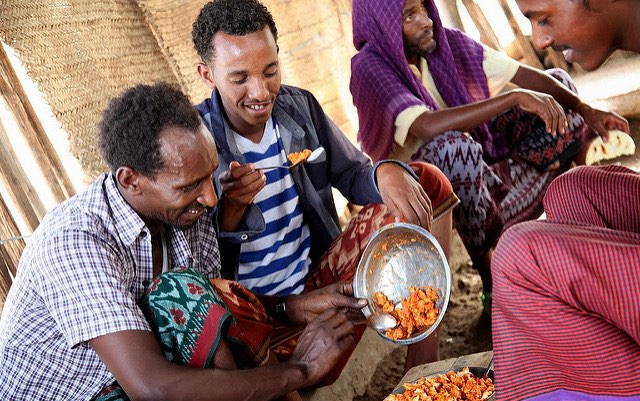A new Ethiopia has emerged in recent years. A potent combination of increased agricultural productivity, urbanization, and economic growth has improved the standard of living for many Ethiopians. As a result, diets are changing as well, but not entirely in positive ways. Ethiopians are eating more calories on average and more diverse foods, but are still far short of recommended levels of dietary diversity, even as they may soon face overnutrition problems like overweight and obesity.
As is often the case with rising incomes, one of the first things Ethiopians have changed is how they shop and eat. Our latest research, with Ibrahim Worku Hassen and Mekdim Dereje and published in Agricultural Economics, examines the ways in which the Ethiopian diet has responded to rapid economic change. Even though overall spending has increased by more than 50 percent between 1996 and 2011, Ethiopians are devoting less of their budgets to food. Higher household incomes have meant that over those years Ethiopians have been able to decrease their total share of spending on food by an average of 1.1 percent each year. At the same time, Ethiopians are eating more than 800 more calories per day in 2011 than they were in 1996—good news after long grappling with high rates of stunting and seasonal undernutrition.
Ethiopians are not only spending their money differently, but also changing what they put on the table. They are increasingly demanding higher-value foods, namely animal products, fruits and vegetables, and processed foods. We found between 1996 and 2011, Ethiopians increased the proportion of their food budgets they spend on animal products and fruits and vegetables by more than 2 percent each. Though Ethiopians still consume more total calories from “starchy staples” like cereals (wheat, maize and sorghum), their dominance as a proportion of overall food budgets is falling, as Ethiopians are demanding more expensive or more highly processed items in their place. Teff, for example, is a higher-value cereal emerging as a popular food for wealthier urbanites. As a rule, urban Ethiopians have begun demanding more selection, convenience and higher quality when shopping for food.
The nutrition implications of these changes are serious, and not always positive: Despite their downward trend as the dominant part of food spending, starchy staples still make up the majority of caloric intake. Despite increased demand for fruits and vegetables, Ethiopia is still lagging behind other African nations in their consumption and is nowhere close to the World Health Organization recommendation of more than 400 grams (14oz) per day. This continued pattern hints at an ongoing lack of diversity in diet, one that many have touted as a contributing factor in the undernourishment of children. To accompany all of this, consumption of calories from fats and oils has doubled. In spite of increased purchasing power, many Ethiopians remain far from a nutritious and varied diet.
Not all trends apply across the board, however. Urbanites spend more money on food overall, devoting a higher share of spending to animal products, produce and oils and fats than rural residents. Eschewing crops like enset, the diet in Ethiopian cities is somewhat less starch-dependent than that of rural areas. Furthermore, the income gap in food spending remains: Poorer populations still spend a larger share of their income on food than wealthy people. As a whole, the dietary landscape of Ethiopia remains complex.
While it is good news that Ethiopia’s economic growth is likely to continue the pattern of recent improvements to caloric intake, dietary trends may not all be for the better. Increased urbanization, often accompanied by more sedentary lifestyles and changing food preferences towards animal products and processed foods, may bode poorly for public health in Ethiopia in the near future. These trends often coincide with rises in overnutrition problems like overweight, obesity and noncommunicable diseases. In 2016, more than 20 percent of the urban Ethiopian women in the age of 15 to 49 years were overweight or obese.
A shift to healthier diets is further hampered by the prices of nutritious foods that are rising much faster than starchy staples, fats and sugar. All of this points to the need for more investments and attention to the “high-value” agricultural and livestock sector production, accompanied by changes to food systems (urban markets in particular), to avoid the “double-burden of malnutrition” that would bring malnourishment to rural Ethiopia and obesity to its cities.
Bart Minten is a Senior Research Fellow and Kalle Hirvonen is a Research Fellow in IFPRI’s Development Strategy and Governance Division. They are based in Addis Ababa, Ethiopia. This post first appeared on Malnutrition Deeply.







